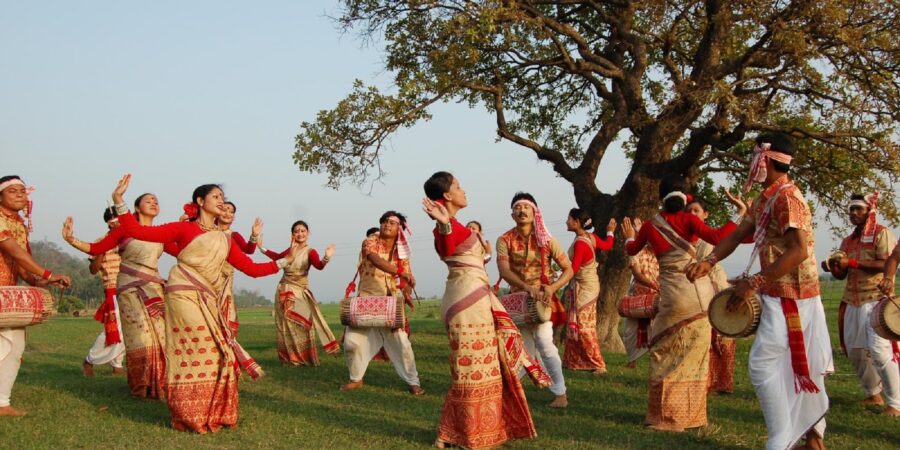 Bihu, a popular folk dance from the northeastern state of Assam in India, is a vibrant celebration of life, culture, and the bounties of nature. It is an integral part of Assamese identity and is performed during the Bihu festival, a significant agricultural festival that marks the changing seasons.
Bihu, a popular folk dance from the northeastern state of Assam in India, is a vibrant celebration of life, culture, and the bounties of nature. It is an integral part of Assamese identity and is performed during the Bihu festival, a significant agricultural festival that marks the changing seasons.
This dance is mainly performed during the harvest season and during the festivals of Bihu. Bihu is a set of three different festivals celebrated in January, April, and October. The name of the three festivals are Rongali or Bohag Bihu, which is celebrated in April, Magh or Bhogali Bihu, which is celebrated in January and Kati or Kongali Bihu, which is celebrated in October. The Bihu dance is a lively and energetic dance performed to the beats of traditional drums and instruments. The dancers move in a circle, clapping their hands and singing traditional songs. This dance is mainly performed by the young people of Assam, as it is a very good way to express their joy and happiness.
The history of Bihu dance can be traced back to the Ahom kingdom, which was established in the 13th century. The Ahom kingdom was ruled by a group of people known as the Tai people. The Tai people had their own culture and traditions, different from the other people of Assam. The Ahom kingdom was very prosperous, and the people of Assam enjoyed a very good standard of living.
The Tai people brought their dance form to Assam, known as the Bihu dance. This dance was originally performed by the men of the Tai community. However, over the years, the community’s women also started participating in this dance. The Bihu dance slowly started becoming popular among the people of Assam and is now considered one of the state’s most important dances. The dance is performed during the Bihu festival, which is celebrated three times a year – in spring (Bohag Bihu), summer (Magh Bihu), and autumn (Kati Bihu). The Bihu dance is performed by both men and women and is a lively dance that involves a lot of energy and enthusiasm.
Bihu is a traditional folk dance of Assam, performed to mark the arrival of the Assamese New Year. It is also known as Magh Bihu or Bohag Bihu. The dance is accompanied by music, which is typically played on the drums and cymbals. The three steps involved in the Bihu dance are as follows:
- The first step is known as “Dhak,” which the men perform. They form a circle and beat the drums rhythmically.
- The second step is known as “Pepa,” performed by the women. They also form a circle and clap their hands to the beat of the drums.
- The third and final step is known as “Bihu,” performed by both men and women. They join hands and dance around the drum in a circle.
These three steps are repeated several times throughout the dance. The dance is usually performed during the harvest season but can also be seen at other festivals and celebrations.
The Bihu dance symbolizes joy and unity and is a great way to experience the culture of Assam. It is celebrated thrice in a year, viz. Rongali or Bohag Bihu in April, Magh Bihu in January, and Kati Bihu in October corresponded to the Assamese months of Bohag, Magh, and Kati. Bohag Bihu, also called the Spring Festival, is the most important and widely celebrated. Bihu is a folk dance of Assam performed to mark the different agricultural phases and express joy and happiness. The young men and women of the village dress up in traditional clothes and perform the Bihu dance to the beats of the dhol and to the tunes of the pepa, a traditional wind instrument.
The Bihu dance is performed in a circle, with the dancers moving in and out while clapping their hands and singing Bihu songs. The dance is accompanied by the music of the dhol, a traditional drum, and the pepa, a traditional wind instrument. The dancers move in a circle, clapping their hands and singing Bihu songs. The dance is a symbol of the joy and happiness of the Assamese people. The Bihu dance is an important part of the Assamese culture and is enjoyed by people of all ages. It is a great way to connect with the Assamese culture and celebrate the agricultural year’s different phases.
Bihu dance is not just a dance form but a celebration of life, culture, and the profound connection between people and nature. Rooted in Assam’s agricultural tradition, Bihu holds immense cultural significance and plays a crucial role in preserving and promoting the region’s rich heritage. As communities come together to perform this lively and energetic dance, Bihu continues to spread joy, strengthen social bonds, and keep alive the vibrant traditions of Assam for generations to come.


